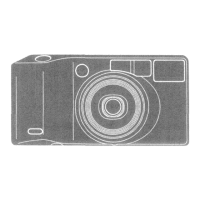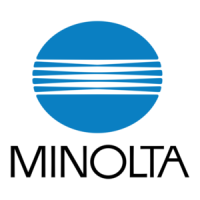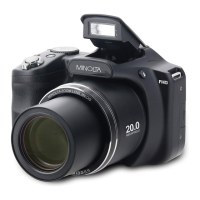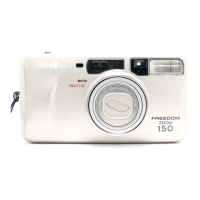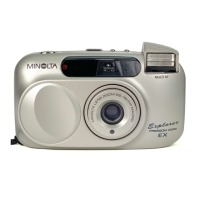/A,
TECHNICAL DETAILS
Lens:
38-14omm
t13.5-9.4
power
zoom
lens;
8
elements
in 7
groups
(including
2
double-sided
aspheric
elements);
max. magnification:
approx.
1/4X
(Macro
mode,
f
=
1o5mm)
Focusing
Range: 38mm:
O.8m
(2.6
ft.)
-
6;
14Omm:
0.65
(2.1
ft.)-
o;
Macro:0.5m
(1.6ft.)-
o
Metering
Range
(lSO
100):
38mm:
EV 2.4-17
(f
13.5,
2.4 sec.
-
f
116,
1/50O
sec.);
14Omm:
EV
4.5-17
(t19.4,4
sec.
-
ll20,
1/315 sec.)
Flash
Range
(lSO
100): 38mm:
0.8
-
5.5m
(2'6
-
18 ft.);
14Omm:
0.65
-
3.1m
(2J
-
1O.2 ft.l,
Macro:
O.5
-
3.8m
(1.6
-
12.5tt.|
Batteries:
2 3V
lithium
batteries
(CR123A)
Battery
Performance:
Approximately
23 rolls
(based
on
Minolta's standard
test
method
using
24 exposure
film with
f lash 5Oo/o
of exposures)
Viewfinder:
Magnification:
38mm:
O.4OX;
14Omm:
1.32X
(subject
at
4m)
Field of
view: 85o/o
(for
subject
at 3m)
Dimensions:
Standard
model:
132.5
x
70.5
x
59mm
15-114
x
2-314
x
2-5116
in.)
DATE
model:
132.5
x
7O.5
x
63mm
$-114
x
2-314
x
2-112
in.l
Weight
(without
batteries):
Standard
model:
3159
fi1-118
oz.l
DATE model:
32Og
(11-5/16
oz.)
Specifications
are
based on
the
latest
informa-
tion
available
at the
time of
printing
and are
sub-
ject
to change
without
notice.
This
device complies with
Part
15
of
the FCC
Rules.
Operation
is
subject to the
following
two
conditions:
(1)
This device may not
cause
harmful
interference,
and
(2)
tfris device must accept any
interference
received, including interference
that
may cause
undesired operation. Changes or
modi-
fications not
approved by the
party
responsible
for
compliance could void
the user's authority to
operate the equipment.
This
equipment
has
been
tested and
found
to comply
with
the limits for
a
Class
B
digital device,
pursuant
to
Part 15
of the
FCC Rules. These limits
are
designed
to
provide
reasonable
protection
against harmful interference
in
a
residential installation.
This eqdipment
gen-
erates,
uses
and can radiate radio frequency
energy and,
if not installed
and used
in
accordance
with
the instructions, may cause harmful inter-
ference
to
radio
communications.
However.
there
is no
guarantee
that interference will not occur in a
particular
installation. lf
this
equipment
does
cause
harmful interference
to
radio
or television
reception, which
can be determined by turning the
equipment
off
and
on, the user
is encouraged to try
to correct the
interference
by one or
more
of the
following measures:
.
Reorient
or relocate the receiving antenna.
o
Increase the
separation
between
the equipment
and
receiver.
.
Connect the equipment
into
an outlet on a circuit
different from that to
which
the receiver is con-
nected.
.
Consult the
dealer
or
an
experienced
radio/-lY
technician
for help.
This
Class
B
digital apparatus
meets all requirements
of the Canadian Interference-Causing
Equipment
Regulations.
36
37

